|
 Underground Constructions:
(Form and Function)
Underground Constructions:
(Form and Function)
There are several
well known examples of ancient underground complexes ...
...and a great many
more rumoured to exist.
|
Featured Underground Sites -
Quick links:
|
Apart from the obvious benefits of
protection, underground sites served as symbolic entrances to the
underworld, as demonstrated by the 'sybill's' of ancient
Greece, who invariably frequented natural openings in the ground for
their
Oracle centres. The Greeks used to place 'Omphalus'
over smaller 'entrances to the underworld'. The same
traditions exist throughout megalithic Europe and around the ancient
world.
Recent Discoveries:
Article:
(Sept, 2012) NewsDiscovery.com:
'First Ever
Etruscan Pyramids Found in Italy'.
Archaeologists have started clearing an underground
pyramid-shaped vault, the top part of which has been used as a
wine cellar in recent times. As they cleared away the top part,
a series of tunnels, again of Etruscan construction, ran
underneath the wine cellar hinting to the possibility of deeper
undiscovered structures below. Beneath the cellar floor, they
found 6th and 5th century B.C. Etruscan pottery with
inscriptions as well as various objects that dated to before
1000 B.C. Digging through this layer, the archaeologists found 5
feet of gray sterile fill, which was intentionally deposited
from a hole in the top of the structure.
"Below that
material there was a brown layer that we are
currently excavating. Intriguingly, the
stone carved stairs run down the wall as we
continue digging. We still don't know where
they are going to take us," The material
from the deepest level reached so far (the
archaeologists have pushed down about 10
feet) dates to around the middle of the
fifth century B.C. "At this level we found a
tunnel running to another pyramidal
structure and dating from before the 5th
century B.C. which adds to the mystery,"
'The lead archaeologists are
still perplexed as to the
function of the structure
though it is clearly not a
cistern. Dr. Bizzarri notes
that there is nothing like
these structures on record
anywhere in Italy or the
Etruscan world. Dr. George,
notes that it could be part
of a sanctuary, and calls
attention to the pyramid
structures that were
described in the literary
sources as being part of
Lars Porsena�s tomb.
Lars Porsena was an Etruscan
king who ruled Chiusi and
Orvieto at the end of the
6th century. Dr. Bizzarri is
however cautious that even
this parallel is not exactly
what is beginning to appear
here, but it does open up
intriguing possibilities.
Both agree that the answer
waits at the base level
which could be 4, 5 or more
metres below the layer they
have now reached'.
(Quick-link)
(More
about the Etruscans)
Article: (Mail Online.
August, 2011).
'Massive European Network of Stone-age Tunnels'
Stone Age man created a massive
network of underground tunnels criss-crossing Europe from Scotland
to Turkey, a new book on the ancient superhighways has claimed.
German archaeologist Dr Heinrich Kusch said evidence of the tunnels
has been found under hundreds of Neolithic settlements all over the
continent. In his book - Secrets Of The Underground Door To An
Ancient World - he claims the fact that so many have survived after
12,000 years shows that the original tunnel network must have been
enormous.
'Across Europe there were
thousands of them - from the north in Scotland down to the
Mediterranean...Most are not much larger than big wormholes -
just 70cm wide - just wide enough for a person to wriggle along
but nothing else...They are interspersed with nooks, at some
places it's larger and there is seating, or storage chambers and
rooms...They do not all link up but taken together it is a
massive underground network.'
(Click
here for full article)
Featured Underground
Locations:
The Giza plateau is
composed of limestone, a geological feature which creates natural
crevices and pockets in the stone somewhat like Swiss cheese.
Perhaps not so strange then that Giza was known anciently as 'Rostau',
meaning the "mouth of the passages". The existence of lost tunnels
and chambers running beneath the surface of the Giza complex has
been suspected for a long time and recent surveys have supported the
idea that there is still much to learn. However, the discovery of
illicit tunnelling in the houses in front of the Sphinx has opened a
new chapter on the history of Giza.
In 2009, a story
emerged of a collapsed illegal tunnel in the Giza village of Nazlet
El Smaan, causing the
deaths of 6 men.
Although very little was made of the story, a selection of
photographs and recorded conversations proved that tunnelling
beneath the houses was being financed and operated surreptitiously
and rumours were surfacing that that major finds were being
discovered.

Picture of the tunnel before it
collapsed
(Photo Credits:
http://www.richardgabriel.info)
Following the collapse, the site was abandoned and now
lies derelict in the middle of the village. Perhaps less well known
is that the very same spot had been identified in publications years
before by Zahi Hawass and Mark Lehner as the most likely position
for the undiscovered Palace/Tomb of Khufu.
(Link
to Full Article)
These 24
hand-carved caves were only discovered late in the 20th century.
Until then they were thought of as natural reservoirs within which
villagers used to collect fish. In 1992, a local villager decided to
pump one of the caves of its water, revealing the startling immense
carved chambers running as deep as 30m and covered with a beautiful
pattern of chisel marks on all the walls and ceilings.
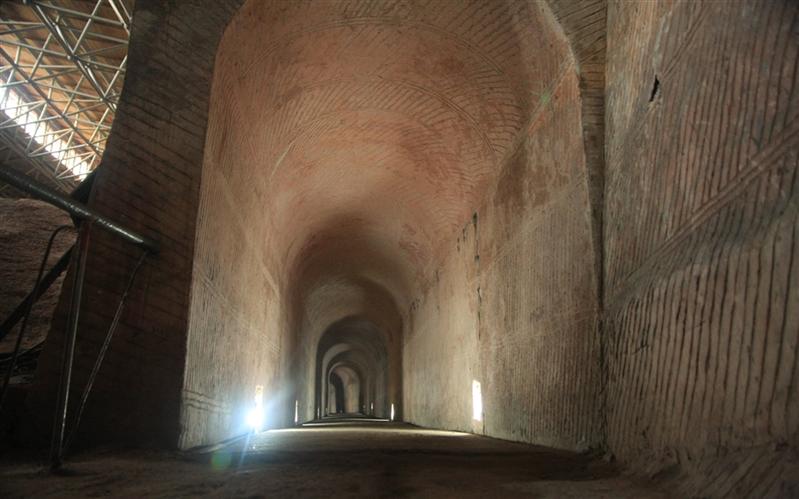
Although the
overall excavation involved almost a million cubic metres of
stone, there is no historical record of them or evidence of the
removed stone.
Their origin is
a complete mystery.
(More
about the Longyou caves)
|
The Mayan Portal to the Underworld (Xibalba): |
Article: June 2009:
travelexplorations.com
In August 2008,
Mexican Archaeologists discovered the place where Mayans prepared
for life after death on the Yucatan Peninsula in Mexico.
Archaeologists have been exploring a maze of stone temples in
underground caves, some submerged in water and containing human
bones.
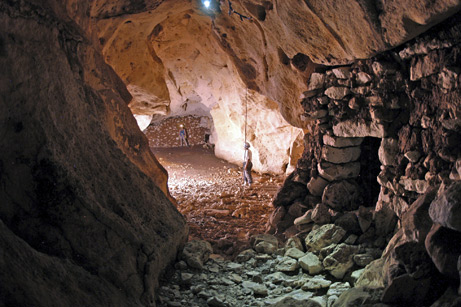
The ancient Mayans
believed Xibalba was a portal where dead souls entered the
underworld.
Researchers
discovered the stone ruins of eleven sacred temples and what could
be the remains of human sacrifices at the site in the Yucatan
Peninsula. Archeologists say Mayans believed the underground complex
of water-filled caves leading into dry chambers, including an
underground road stretching some 330 feet, was the road to a
mythical underworld, known as Xibalba.
According to an
ancient Mayan scripture, the Popol Vuh, the route was filled with
obstacles, including rivers filled with scorpions, blood and pus and
houses shrouded in darkness or swarming with shrieking bats,
Guillermo de Anda, one of the lead investigators at the site.
Excavations in the Yucatan caves have so far revealed stone carvings
and pottery left for the dead.
Different Mayan
groups who inhabited southern Mexico and northern Guatemala and
Belize had their own entrances to the underworld which
archaeologists have discovered at other sites, almost always in cave
systems buried deep in the jungle. In the Yucatan site they have
found one 1,900-year-old ceramic vase, but most of the artefacts
date back to between 700 and 850 A.D.
Teotihuacan,
Mexico.
Recent
archaeology (Aug. 2010), has revealed a tunnel system running
under the Pyramid of 'The Feathered Serpent' at Teotihuacan in
Mexico. It is believed to date from before the pyramids and is
hoped it will be found to contain the remains of the ruling
elite and their funerary regalia.
(Teotihuacan
and the Pyramid of the Feathered Serpent)
(More
about Ancient Mexico)
|
The 'Lost' Labyrinth of Egypt: |
It was recently
announced that the lost labyrinth of Egypt at Hawara has been
re-discovered by an expedition funded by
NRIAG,
Ghent University/Kunst-Zicht
& Louis De
Cordier, with the cooperation of the
Supreme Council of Antiquities, Horus Foundation &
Isel
Foundation.

This colossal temple was described
in the past by authors such as Herodotus and Strabo, and was said to
contain 3,000 rooms full of hieroglyphs and paintings. When Petrie
first discovered the great artificial stone surface (304m by 244m)
in 1889, at the depth of several meters, he interpreted it as the
foundation of the labyrinth. New evidence suggests that the
stone plateau may in fact be the roof of the great complex.
(More
about the 'Lost Labyrinth')
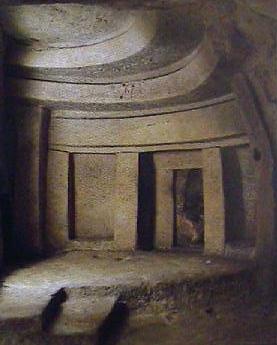
This
underground spectacular takes one straight to the heart of the
prehistoric psyche. It includes features such as carved
trilithons,
spirals, 'speaking' chambers, and the
possible use of 'Ergot'. These fantastic chambers reek of ritual and
mystery.
The Hypogeum is
orientated so that the 'holy of holies' inside faces the equinoxial
sun. Such a feature, combined with the discovery of several thousand
skulls, makes it extremely likely that the site was used as a
connection to the afterlife.
(More about the Hypogeum)
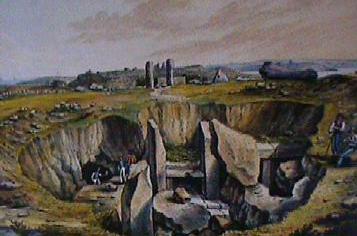
A second hypogeum (The
Hypogeum II), has been discovered on Gozo Island (next to
Malta), it is directly under and in the centre of the prominent
Xaghra stone circle.
|
The Osireion (Strabo's Well), Abydoss, Egypt: |
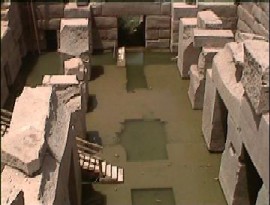
This
fantastic underground structure dates back to the earliest roots of
dynastic Egypt. The stark, unadorned masonry can only be seen in one
other place in Egypt; The 'Valley-temple' beside the Sphinx at
Ghiza.
It is noticeable that
while the Osirion at Abydoss is connected to Osiris through myth
(being the resting place of his 'Phallus', which was swallowed by
cat-fish...), the Valley-temple at Ghiza on the other hand, is
associated with Isis through the 'Inventory stele', found inside the
temple, which says of Khufu...
He found the house of Isis, Mistress of the Pyramid, by
the side of the hollow of Hwran (The Sphinx)
The
water of the
Osireion is connected to the Nile, meaning
that it creates a 'moat' around the central 'island' when the waters
are down. The rock is cut deep into the waters so that the bottom is
not visible in places.

This underground city is one
of five in the area that connect together, making an underground complex with the
potential for 100,000 people. The 'city' has apartments, running water,
air-conditioning, and large doors roll across the entrances, locking from the
inside, presumably protecting the inhabitants from...???
These unique underground cities
are currently being excavated and access is restricted. We would welcome any
eye-witness or photographs of this site...
(More
about Derinkuyu)

This ancient site (dated at 800 BC), includes a network
of underground tunnels at the heart of which sits this monolith, called El-Toro ('The
Bull'). The fully decorated stone stands at 4.5m high and the top protrudes through the
ceiling and into the room above.
This classic 'Chavin' site also includes
other great feats of masonry, including cyclopean masonry (a 30 ft long lintel) and
several similarly carved standing stones.
(More
about Chavin du Huantar)
Location - Cuenca,
Equador. - Vast tunnel network. (17).
Location �
Columbia. San Augustin. Underground sanctuaries with connecting
passages. (18). These supposed underground sanctuaries are in fact the
underground Hypogea at relatively nearby Tierradentro, which was inhabited
by the 'San Agustin' civilisation, however, there is no evidence ofany
connected tunnels.
(More about Tierradentro, Columbia).
Location � Peruvian
Andes, Huascaran, 22,203 ft high, near the village of Otuzco.
Cave entrances closed with slabs of rock. First recorded by Francis Pizzaro
(1478-1541). An expedition was organised in 1971, an account of which was
given in the periodical �Bild der Wissenschaft�.
�Vast tunnels which would leave even modern underground constructors green
with envy began behind six �doors�. These tunnels lead straight towards the
coast, at times with a slope of 14 per cent. The floor is covered with stone
slabs that have been pitted and grooved to make them slip-proof. It is an
adventure even today to penetrate these 55 to 65 mile-long transport tunnels
in the direction of the coast and finally reach a spot 80 ft below sea
level. The great ocean lurks at the end of the underground passage of �Guanape�,
so called after the island that lies off the coast of Peru here, because it
is assumed that the passages once led under the sea to the island. After the
passages have gone uphill and downhill several times, and after a downhill
slope, they end in ocean water".
(18).
(More about
ancient Peru)
Location
- India. Kanheri, near the Malabar coast.
The �Rock Temples�, consisting of 48 ft high caves, blasted from granite
they run several stories deep. The ceilings are supported by granite
pillars, carved from the rock. Decorated in relief.
(18).
|